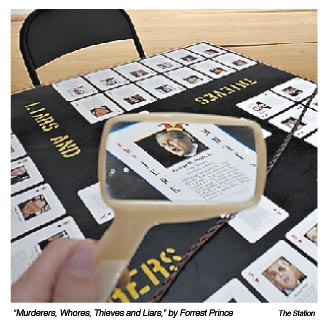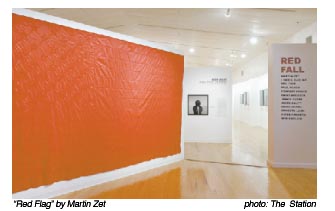Art-Y-Facts
Houston doesn’t have many public plazas, so we try to get maximum impact from the few we can boast of. So, not satisfied with being home to Halliburton Plaza, which is located at the ballpark formerly known as Enron Field, we recently celebrated the unveiling of the George Bush Monument, a downtown statue and plaza that pays homage to Bush the Elder. At the unveiling, a former local television anchor described 41 as “the most important Houstonian ever…with the possible exception of Sam Houston,” which no doubt came as news to the shades of Jesse Jones and Will Hogg. Not to mention Dominique de Menil and Barbara Jordan. And a local lawyer with so much time on his hands that he was able to dream up the Monument, chimed in with, “No president was so closely identified with his home city as President Bush.” Which was news to all of us who remember that, for decades, the Houstonian Hotel served as GHWB’s local address.
The lawyer, a certain Charles Foster, praised the former president for agreeing to be depicted as standing on his own two feet at street level, like an ordinary mortal. “We didn’t put him on a pedestal or on horseback,” said Foster, “because we wanted the statue to be accessible. We wanted it to reflect the modesty of a great man.” Foster went on to predict that the Monument would become as popular a tourist attraction as NASA and the museums, and to venture a comparison between Abraham Lincoln and George H.W. Bush. There was no word as to whether or not Foster was led away in a strait jacket after making that announcement.

Reading this, and imagining the applause of the gathered Bush Mafia—the Bakers, the Mosbachers—you might be thinking that Houston should be leveled and its ruins strewn with salt. But before you mentally wipe us off the face of the earth, consider this: The George Bush Memorial is not the only local art site featuring an image of the former president. In its current exhibition, The Station, an art museum on the eastern fringes of downtown, has a picture of Bush Sr. on a playing card, in the angry yet humorous installation by local artist and holy man Forrest Prince, “Murderers, Whores, Thieves and Liars.” The piece features a table covered with playing cards, using the above titles rather than hearts, spades, diamonds, and clubs. Each card contains a small photo of a powerful creep, and then jauntily details his or her wrongdoing. “Murderer” Colin Powell’s militaristic adventures are touched on, then Prince finishes his text with, “My what big talons you have, Mr. Dove.”
Bush 41, bagman for Carlyle, appropriately appears as one of the “Whores.”
But enough about Bush. The exhibition that Prince’s installation is part of, Red Fall, is just the latest poke in the eye for the powerful by Station director and creator James Harithas, who is himself an at least estranged member of the city’s cultural elite. He is married to Ann Harithas, a member of a prominent Victoria oil and ranching family. Back in the late 1970s James Harithas directed the Contemporary Arts Museum, which he put on the map with a series of provocative shows and art happenings. After he wore out his welcome there he lay low for years, until he and Ann opened the Art Car Museum in 1998, followed by the Station, so that he could show the kind of art he is interested in: polemical and political, made by artists usually ignored by the temples of culture.
Harithas’ most newsworthy show to date is probably Made in Palestine, apparently the first exhibition of Palestinian art shown in the United States. (Harithas was hoping the show would travel, but he couldn’t find any institution willing to risk alienating some of their funders.) But the current Red Fall is equally powerful.
The shock of the show begins with its title, which rather chillingly predicted the current United States political map. (Harithas could find work as a fortune teller. As soon as Bush Jr. was elected, Harithas planned a Secret Wars show that, post-9/11, drew FBI agents to the Art Car Museum.) But, typically for a Harithas show, he subverts the idea of “redness,” attempting at least to reclaim it from the Right. He also smacks you in the face with it—redness—when you walk through the Station door and are stopped in your tracks by the crimson-red American flag by Czech artist Martin Zet. The flag is such a blazing thing that it speaks for itself—but saying exactly what?
The “red” theme continues through some of the other installations. In “World Revolution,” Zet has a videotape of himself applying red paint to his face. The accompanying wall text proclaims that red is “the color of the OPPRESSOR AND ALSO OF THE OPPRESSED,” and that red “rejects negative influences” and is “vital passion.”

But not everything is color-coded. You have the Forrest Prince card game, which is apparently a favorite with visitors. Lowell Darling has a clever and truly thought-provoking video, “Run Yourself for President,” which shows John Kennedy’s “I am a Berliner” speech, and then invites Berliners (and others) to declare their candidacy for JFK’s old job. Darling writes, “Today I say every citizen of Berlin should be allowed to vote for President of the U.S.”
Mel Chin’s video installation, “S.O.S. Urgent,” attempts to portray our inner political lives. He videotaped a very diverse group of people in close-up, and asked them their thoughts on the then-upcoming election. He runs their words as a crawl beneath their silent faces, all accompanied by a rather ominous thumping soundtrack, which may or may not be the sound of a beating heart. A few messages cheer Bush on, but most go something like, “You shouldn’t be concerned with gay marriage when our soldiers are dying.”
Paul Fusco’s “Fallen Soldiers” is a moving series of photographs from funerals for U.S. soldiers. Janós Sugár’s “Typewriter of the Illiterate” is a riveting video showing images of presumably poor people around the world posing with their automatic weapons. At one moment, a tribal warrior in Central Asia morphs into a tribal warrior in Africa, each brandishing his Kalashnikov in roughly the same way.
The most unnerving piece is David Krueger’s “Bringing the War Home.” This is an installation so tucked away into a corner of the exhibit space that you might be hesitant to enter. Once inside, you find yourself first in a shattered Iraqi house, and then in a humble American home—you walk from one into the other. The Iraqi house is in complete upheaval, and is easy enough to decipher. You have to work harder on the American house, straining to see that it has been raided by someone—the FBI? Drawers are pulled open and the computer is smashed. “Traitor” is spray-painted on the wall. The space is appropriately claustrophobic.
There are other powerful pieces as well, such as Ilkka Uimonen’s “Statute,” a series of photos, hung at conflicting angles, showing richly textured but heartbreaking black and white scenes from the Iraq war. Looking at them and at the projected images in the middle of the room, you have the sense of seeing an unreported, almost unknown war.
But the single installation that held my attention the longest is Martin Zet’s Third Reich “rap video.” It shows Hitler performing his infamous jig at the news that France had surrendered, while Goering joins in the joy. Zet runs the brief footage on a loop, accompanied by a rap song by Swollen Members. I couldn’t make the words out, but as a background beat for the Hitler hop, the song was irresistible. Of course, the whole thing has a truly subversive Three Stooges flava.
And what about the Bushes? Forrest Prince made the current president the centerpiece of his card game. Surrounded by Aces, heads of the IMF and such, Jr. is the Joker. Or, as the normally beatific Prince has it, the Jerk.
David Theis is the author of Rio Ganges, a novel set in Mexico. He lives in Houston.


